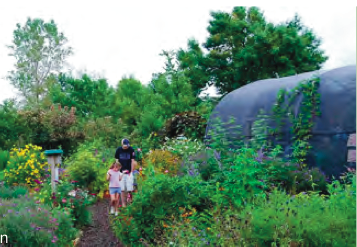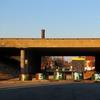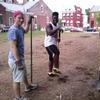Use Native Plants for Habitat or Biodivsersity
Native plants and flowers are typically hardiest and most acclimated to St. Louis growing conditions
Description

Native plants and flowers indigenous to Missouri are typically hardiest and most acclimated to St. Louis growing conditions. Native species are well-suited to the local climate and soil, and they attract beneficial insects, birds, bees, and other creatures to create a healthier and more biodiverse urban habitat. They usually require less water, chemical fertilizer, and maintenance so they keep soils, rivers, and streams healthy, and improve human connection with landscape and wildlife. Natives attract pollinators and enhance urban production of herbs, fruit, vegetables, and honey. They beautify the neighborhood and encourage active living, education, and monetary savings.
Related Tools
When paired with other tools, native plants can make a greener, healthier, and more beautiful neighborhood. Think about saving water and energy, local food, urban gardens, and green infrastructure. Native plants and flowers can work well with the following tools:
Community Projects
Get inspired by related local projects
-
 Thurman Gateway
Thurman Gateway was a project designed to transform the blighted Highway 44 underpass at Thurman and...
Thurman Gateway
Thurman Gateway was a project designed to transform the blighted Highway 44 underpass at Thurman and...
-
 McKinley Meadows
“McKinley Meadows”, an edible and pollinator garden, inspired McKinley Heights residen...
McKinley Meadows
“McKinley Meadows”, an edible and pollinator garden, inspired McKinley Heights residen...
Neighborhood Benefits
Environmental
- Improved biodiversity, local habitat, and neighborhood greening Conserved water use and filtered stormwater runoff
- Reduced fertilizer pollution in rivers and streams
- Improved air, water, and energy savings and lowered local temperature
- Improved air quality from carbon sequestration
- Decreased chances of invasive plant species
Social
- Reduced exposure to harmful chemicals
- Improved public perception of the neighborhood or site
- Increased access to natural areas for beauty, recreation, and learning
Economic
- Reduced funds spent on replanting, yard waste disposal, fertilizer, water, lawn mowing, and long-term maintenance
- Potential to sell products like honey or berries
Get Started
- Vision Create a long-term vision and goal for the program or a green committee that is inclusive of the entire community, including youth, seniors, business owners, and all residents. Consider the organizing structure, future projects, and possible partners.
- Inform To benefit the community most, the pilot project should be visible and accessible to the public and have educational material and signage to inform visitors about the project and program.
- Brainstorm Brainstorm what kind of native plant project or program will be best for your neighborhood. Ask the following questions:
-
- Who will maintain the project or run the program?
- How will neighbors benefit in the future, and how can they be involved?
- Does the neighborhood association have funding or will outside resources be needed?
- What are the objectives Habitat; Education; Pollination; Green Space; Water Filtration; or Attracting birds, bees, and butterflies?
-
- Research There are numerous resources available in St. Louis for getting ideas, how-to instructions, examples, guidance, and funding for creating a native landscape project. Helpful organizations are Gateway Greening, Brightside St. Louis, PAUSE St. Louis Zoo, the EPA, and Wild Ones. To determine what native plants are best suited for your project, where to plant them, and how to care for them, visit Missouri Botanical Garden, Grow Native!, and Missouri Department of Conservation. For Information about birds, insects, and other fauna, visit St. Louis Audubon Society, Powder Valley Conservation Center, and Missouri Department of Conservation. Some other helpful links can be found on blogs, including St. Louis Zoo Beneficial Pollinators, Urban Farm Online, Startabeehive.com, and Fromthebathtub.
- Find a Site If working on public property such as a park or Land Reutilization Authority (LRA) owned lot, be sure to coordinate with the Parks, Recreation, and Forestry Department or the St. Louis Development Corporation (SLDC). LRA properties can usually be leased for a nominal fee if your use is approved.
- Design Design a pilot project. Use the above listed resources to create a design and construction plan. Work with those resources and perhaps a local gardener or landscape architect to help with the design. Consider the maintenance and upkeep of the landscape and who will be responsible for its care, particularly if there are active elements like bees or harvesting of fruits, vegetables, or herbs. Ensure the overall safety of residents in the design and placement of active elements.
- Organize Organize and advertise workdays. Contact your neighborhood association for help and volunteers. Ensure that you have plants, soil, and other materials delivered on time. Ask community members to lend tools, gloves, and other necessary equipment for planting or plan to buy necessary equipment beforehand.
- Work Host your workday(s)! Gather and assign tasks to your volunteers and build your native landscape. Organize this event at the right time of year so your plants will thrive and your naturescape will be successful. Plan for maintenance and upkeep days following the initial workdays to make sure your plants are flourishing.
Opportunities
Related Categories
Sustainability Plan Categories
Project Scale
- Park
- Private Site
- Public Building
Download This Tool
Use Native Plants for Habitat or Biodiversity Doc (827.00 KB pdf)
Need Help Viewing?
You need a program that can open Adobe PDF files. A free option:
- Adobe Reader can read PDF files